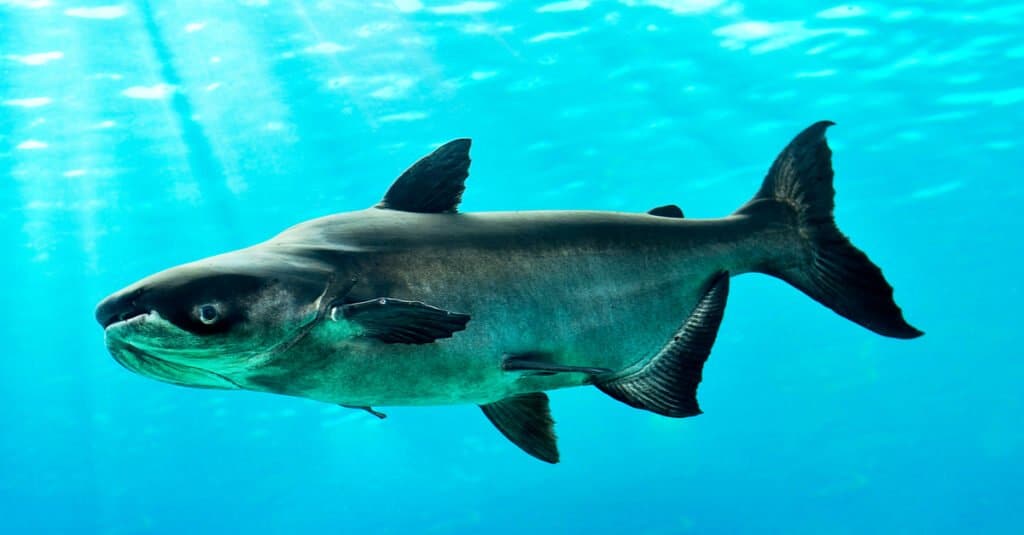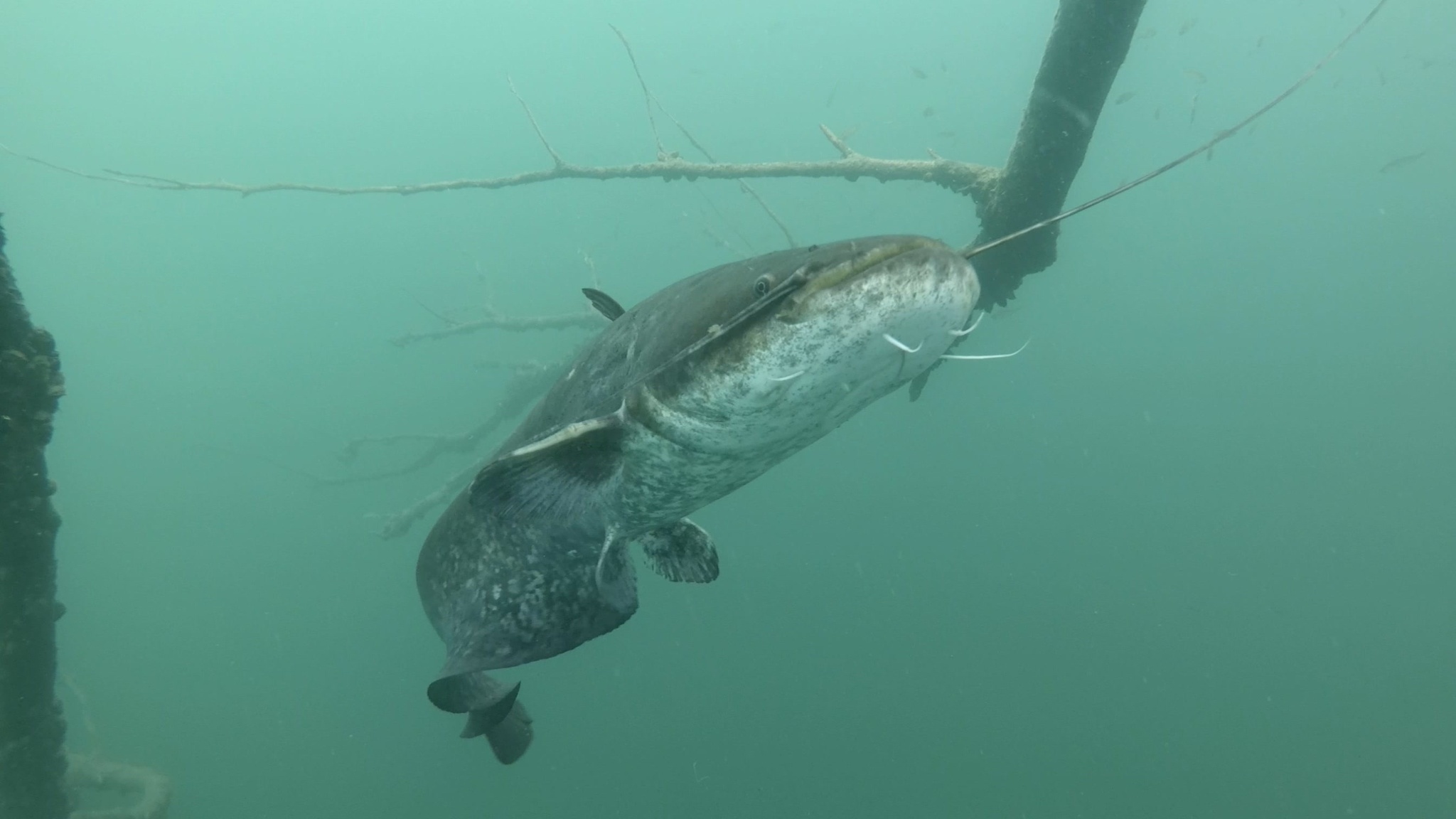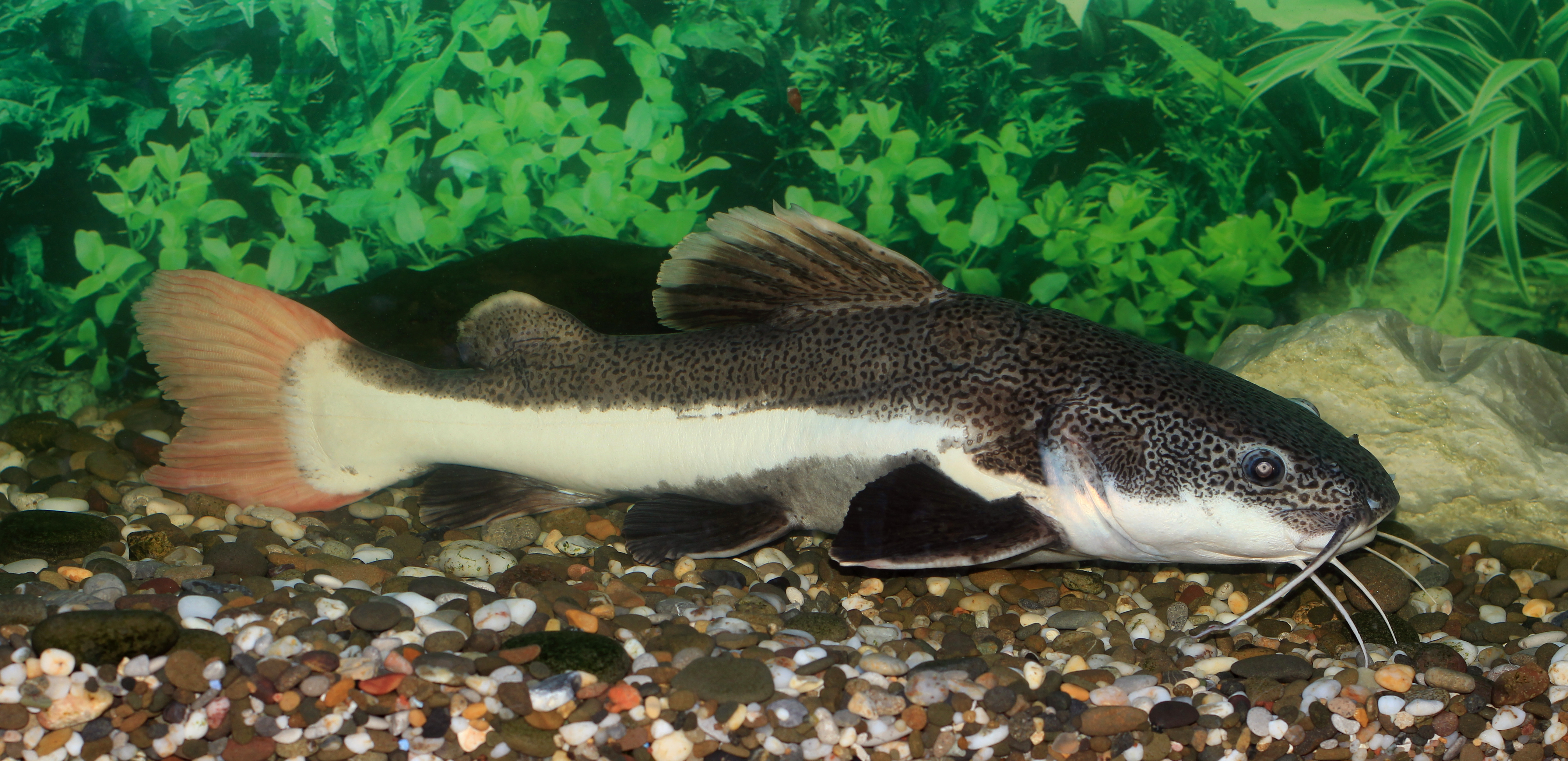Catfish are a diverse group of fish that are found in freshwater environments all over the world. With almost 3,000 known species, catfish rank second or third in diversity among orders of vertebrates.
Catfish are named for their prominent barbels, which resemble a cat’s whiskers, and they range in size and behavior from the smallest known vertebrates, such as the candiru, to the largest reported freshwater fish, such as the Mekong giant catfish.
You are reading: Discover 10 Types Of Catfish Ranked By Size
In this article, we will discover 10 types of catfish ranked by size, including some of the largest catfish species in the world.

10 Types Of Catfish Ranked By Size
Wels Catfish (Silurus glanis)

The Wels Catfish (Silurus glanis) is a large species of catfish native to central, southern, and eastern Europe, in the basins of the Baltic, Black, and Caspian Seas. It prefers large, warm lakes and deep, slow-flowing rivers.
The Wels Catfish can grow up to 10 feet long and live. It is a nocturnal predator that forages near the bottom and in the water column. Larvae and juveniles are benthic, feeding on a wide variety of invertebrates and fish, while adults feed on fish, frogs, water birds, and occasional small mammals.
The Wels Catfish is an important food fish and a fine sport fish. It has been introduced to Western Europe as a prized sport fish and is now found from the United Kingdom east to Kazakhstan and China and south to Greece and Turkey.
Piraiba (Brachyplatystoma filamentosum)
Brachyplatystoma filamentosum, commonly known as Piraiba, is a species of large catfish that is native to the Amazon and Orinoco River basins and rivers in Guianas and northeastern Brazil. It is the largest catfish of the Amazon basin, with adults typically measuring 2000 – 2500 mm (2 – 2.5 m) and weighing in excess of 150 kg.
The largest Amazon Piraiba on record was 2 – 2.5 m long and weighed more than 150 kg. The Piraiba is a widespread species that is found in rivers and estuaries of Amazon and Orinoco watersheds, Guianas, and northeastern Brazil.
Juveniles exhibit dark body coloration with a light belly, while adults have a dark to light grey dorsum with small dark spots on the caudal-fin or peduncle and a dorsal fin with pink shading. The Piraiba is an important food fish and, to some extent, an aquarium fish.
Mekong Giant Catfish (Pangasianodon gigas)
The Mekong Giant Catfish (Pangasianodon gigas) is a critically endangered species of catfish in the shark catfish family, Pangasiidae, native to the Mekong basin in Southeast Asia and adjacent China. Here are some interesting facts about the Mekong Giant Catfish:
– It is the largest freshwater fish in the world, reaching up to 10 feet in length and weighing over 600 pounds.
– The Mekong Giant Catfish is now only found in the lower Mekong River and is considered critically endangered due to overfishing and habitat loss.
– It has one of the fastest growth rates of any fish in the world, reaching 150 to 200 kg in just 6 years.
– The Mekong Giant Catfish migrates long distances to spawn, swimming upstream from the Mekong Delta to northern Thailand and Laos.
– The fish is grey to white in color and lacks stripes, distinguishing it from other large catfish species in the river by the near-total lack of barbels and the absence of teeth.
– Young Mekong Giant Catfish do exhibit barbels and oral teeth, but these disappear as they mature.
– The fish is an important food fish and is also raised in aquaculture.
– Large fish are now caught regularly in some Thai reservoirs, but there is no evidence of self-sustaining populations.
Read more : Discover 7 Types Of Rattlesnakes In New Mexico
Overall, the Mekong Giant Catfish is an impressive and fascinating species that is unfortunately facing significant threats to its survival.
Goonch Catfish (Bagarius yarrelli)
Bagarius yarrelli, also known as the Goonch Catfish, is a very large species of catfish found in rivers in the Indian subcontinent. Here are some interesting facts about the Goonch Catfish:
– The species reaches up to 2 meters (6.6 feet) in length.
– It is known by many names throughout its range in the Indian subcontinent, including goonch, baghar, baghair, gauns, gorua, baghmas, and bodh.
– The Goonch Catfish is a nocturnal predator that feeds on fish, crustaceans, and other aquatic animals.
– It is a popular food fish and is fished for across much of its range.
– The Goonch Catfish is also a popular aquarium fish, although it requires a large tank and can be aggressive towards other fish.
– The species is sometimes considered synonymous with B. bagarius, another large species of catfish found in the same region.
– The Goonch Catfish has gained notoriety in recent years due to reports of attacks on humans in the Kali River in India.
Overall, the Goonch Catfish is an impressive and fascinating species that is an important part of the aquatic ecosystems of the Indian subcontinent.
Redtail Catfish (Phractocephalus hemioliopterus)

The Redtail Catfish (Phractocephalus hemioliopterus) is a species of pimelodid catfish found in the Amazon and Orinoco basins in South America. Here are some interesting facts about the Redtail Catfish:
– The Redtail Catfish is also known as cajaro in Venezuela, banana catfish in Guyana, and pirarara in Brazil.
– It is the only extant species of the genus Phractocephalus.
– The Redtail Catfish is a popular aquarium fish, although its massive adult size makes it unsuitable for all but the largest aquariums.
– The species can grow up to 5.9 feet in length and weigh over 120 pounds.
– Redtail Catfish are omnivorous and feed on fish, crustaceans, and fallen fruits.
– They are not evaluated by the International Union for Conservation of Nature (IUCN).
– The Redtail Catfish is also fished for and is considered a gamefish in some areas.
– The Redtail Catfish is named for its distinctive red or orange caudal fin.
Overall, the Redtail Catfish is an impressive and popular species that is an important part of the aquatic ecosystems of South America.
Blue Catfish (Ictalurus furcatus)
The Blue Catfish (Ictalurus furcatus) is a large species of North American catfish that is native to the Mississippi, Missouri, and Ohio River basins of the central and southern United States. Here are some interesting facts about the Blue Catfish:
– The Blue Catfish is the largest species of North American catfish, reaching up to 65 inches in length and weighing up to 165 pounds.
– The species can live up to 20 years, with a typical fish being between 25–46 inches in length and 30–70 pounds in weight.
– The Blue Catfish is an omnivorous predator that feeds on a variety of prey, including fish, crustaceans, and insects.
– The species has been introduced to a number of reservoirs and rivers outside of its native range, including in California, Florida, and Mexico.
– Blue Catfish are popular gamefish and are also raised in aquaculture.
– The species is an important food fish and is also popular in the aquarium trade, although its large size makes it unsuitable for most home aquariums.
Overall, the Blue Catfish is an impressive and important species that is an important part of the aquatic ecosystems of North America.
Flathead Catfish (Pylodictis olivaris)
The Flathead Catfish (Pylodictis olivaris) is a large species of North American freshwater catfish in the family Ictaluridae. Here are some interesting facts about the Flathead Catfish:
Description:
– As the common name suggests, this catfish has a flat head, but other than that, it looks like any other catfish: it has smooth, scaleless skin, whisker-like barbels around the mouth, and long spines on the dorsal (back) fin and one on each side of the pectoral (shoulder) fin.
– Flathead catfish reach a length of 3 to 4 feet (0.9 to 1.2 m) and their weight can exceed 100 pounds (45 kg).
– Flathead catfish are typically pale yellow to light brown on the back and sides, and highly mottled with black and/or brown. The belly is usually pale yellow or cream colored.
– The head is broadly flattened, with a projecting lower jaw.
Habitat and Distribution:
– Flathead catfish are native to rivers and lakes in the lower Great Lakes and Mississippi River basin.
– They are found in appropriate habitats throughout the Mississippi River drainage, including the Missouri, Ohio, and Tennessee River systems.
– Flathead catfish have been widely introduced and are an invasive species in some areas.
Other Interesting Facts:
– Flathead catfish are also known as yellow cat, mud cat, Johnnie cat, goujon, appaluchion, opelousas, pied cat, and Mississippi cat.
– The species is a popular game fish and is also raised in aquaculture.
– Flathead catfish are typically caught using live bait, such as sunfish or shad, or cut bait, such as skipjack herring or shad.
– The species is not evaluated by the International Union for Conservation of Nature (IUCN).
Overall, the Flathead Catfish is an impressive and important species that is an important part of the aquatic ecosystems of North America.
Channel Catfish (Ictalurus punctatus)
The Channel Catfish (Ictalurus punctatus) is North America’s most numerous catfish species. Here are some interesting facts about the Channel Catfish:
Description:
– Channel catfish are easily distinguished from all others, except blue catfish, by their deeply forked tail fin.
– The upper jaw of the Channel Catfish projects beyond the lower jaw.
– Coloration is olive-brown to slate-blue on the back and sides, shading to silvery-white on the belly.
– Typically, numerous small, black spots are present, but may be obscured in large adults.
Habitat and Distribution:
– Channel catfish are native to North America and are found in freshwater environments throughout the United States and southern Canada.
– They are commonly found in rivers, streams, and lakes.
– Channel catfish have been widely introduced and are an invasive species in some areas.
Other Interesting Facts:
– Channel catfish are the official fish of Kansas, Missouri, Nebraska, and Tennessee.
– They are the most fished catfish species in the United States, with around 8 million anglers targeting them per year.
– Channel catfish are largely omnivorous, feeding on insects, mollusks, crustaceans, fish, and occasional aquatic vegetation.
– The species is an important food fish and is also raised in aquaculture.
– Channel catfish spawn in late spring or early summer when water temperatures reach 75°F.
– Males select nest sites which are normally dark secluded areas such as cavities in drift piles.
Overall, the Channel Catfish is an important and fascinating species that is an important part of the aquatic ecosystems of North America.
Jau Catfish (Zungaro zungaro)
The Jau Catfish (Zungaro zungaro), also known as the Gilded Catfish, is a large species of catfish native to the Amazon and Orinoco basins in South America. Here are some interesting facts about the Jau Catfish:
Description:
– The Jau Catfish is one of the largest catfish species in the Amazon, reaching up to 4.9 feet in length and weighing over 100 pounds.
– The species has a broad, flat head and a wide mouth with long, sharp teeth.
– The Jau Catfish is typically brown or black in color with a golden sheen, giving it its common name of Gilded Catfish.
Habitat and Distribution:
– The Jau Catfish is found throughout the Amazon and Orinoco basins in South America.
– The species prefers deep, slow-moving rivers and is often found near submerged logs and other structures.
Other Interesting Facts:
– The Jau Catfish is an important food fish and is also popular in the aquarium trade, although its large size makes it unsuitable for most home aquariums.
– The species is a popular game fish and is known for its powerful fighting ability.
– Jau Catfish are typically caught using live bait, such as small fish or crustaceans.
– The species is not evaluated by the International Union for Conservation of Nature (IUCN).
Read more : Top 10 Smallest Monkeys In The World
Overall, the Jau Catfish is an impressive and important species that is an important part of the aquatic ecosystems of South America.
Tocantins Catfish (Brachyplatystoma juruense)
Brachyplatystoma juruense, also known as the Gold Zebra Catfish, is a species of catfish native to the Amazon and Orinoco River basins in South America. Here are some interesting facts about the Tocantins Catfish:
Description:
– The Tocantins Catfish is a large species of catfish that can grow up to 60 cm in length.
– The species has a less contrasting color pattern and much higher body in profile than other Brachyplatystoma species.
– The adipose fin is larger and barbels shorter than other Brachyplatystoma species.
Habitat and Distribution:
– The Tocantins Catfish is found in the middle Amazon and Orinoco basins, including many tributary drainages.
– The species inhabits larger, deeper river channels with a sandy substrate and some large chunks of driftwood.
Other Interesting Facts:
– The Tocantins Catfish is a predator and is entirely piscivorous, preying on loricariids and other bottom-dwelling fish.
– The species is not evaluated by the International Union for Conservation of Nature (IUCN).
– The Tocantins Catfish is suited only for specialized aquariums due to its large size.
Overall, the Tocantins Catfish is an impressive and important species that is an important part of the aquatic ecosystems of South America.
FAQS
1. How many types of catfish are there?
There are over 3,000 species of catfish worldwide, with over 30 species found in the United States alone.
2. What is the largest type of catfish?
The Wels Catfish (Silurus glanis) is the largest type of catfish, reaching up to 15 feet in length and weighing up to 660 pounds.
3. What is the most numerous catfish species in North America?
The Channel Catfish (Ictalurus punctatus) is the most numerous catfish species in North America.
4. What is the largest catfish species in North America?
The Blue Catfish (Ictalurus furcatus) is the largest catfish species in North America, reaching up to 65 inches in length and weighing up to 165 pounds.
5. Are catfish popular game fish?
Yes, catfish are popular game fish and are fished for by millions of anglers each year.
6. Are catfish important food fish?
Yes, catfish are an important food fish and are raised in aquaculture.
7. Are catfish suitable for aquariums?
Some catfish species are suitable for aquariums, but their large size makes them unsuitable for most home aquariums.
8. Are all catfish bottom feeders?
Most catfish are bottom feeders, but some species are also known to feed on insects, crustaceans, and other aquatic animals.
9. Are catfish found in both freshwater and marine environments?
Yes, catfish can be found in both freshwater and marine environments, and on every continent except Antarctica.
10. Are all catfish species evaluated by the International Union for Conservation of Nature (IUCN)?
No, not all catfish species are evaluated by the IUCN.
Source: https://petstutorial.com
Category: Animals










